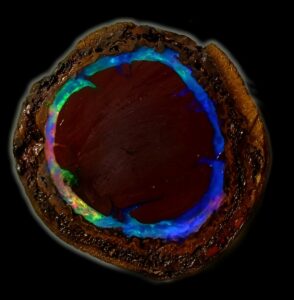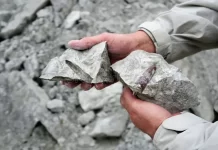
Introduction
Yowah Nut Opal is a unique and captivating gemstone known for its distinctive appearance and vibrant play of colors. Found exclusively in the Yowah opal field in Queensland, Australia, this gemstone is highly prized by collectors and jewelers alike. The name “Yowah Nut” derives from the opal’s resemblance to nuts or nodules, encapsulating the precious opal within a hardened outer shell. This article delves into the geological formation, history, and significance of Yowah Nut Opal, exploring its unique characteristics and the region from which it originates.
Geological Formation
The Origins of Opal
Opal is a mineraloid composed of silica and water, formed through a process of sedimentation. It typically occurs in areas with rich deposits of sandstone and volcanic ash, where water percolates through the earth, dissolving silica from the rocks. This silica-laden water then seeps into voids and cracks in the earth’s crust. Over time, the water evaporates, leaving behind silica deposits that gradually solidify to form opal. The unique play of colors in opal, known as opalescence, is due to the diffraction of light passing through these silica spheres.
Formation of Yowah Nut Opal
Yowah Nut Opal specifically forms within ironstone concretions, or nodules, often referred to as “nuts.” These nodules are typically spherical or ellipsoidal, ranging in size from a few millimeters to several centimeters in diameter. The formation process of Yowah Nut Opal involves several stages:
- Sedimentary Deposition: The region where Yowah Nut Opal is found was once a vast inland sea. Over millions of years, sedimentary layers, including sandstone and claystone, accumulated on the seabed.
- Silica Infusion: As water infiltrated these sedimentary layers, it dissolved silica from the surrounding rocks. This silica-rich water then filled cavities within the ironstone nodules.
- Opalization: Over time, the water evaporated, leaving behind deposits of silica. In favorable conditions, these silica deposits transformed into opal. The opal within Yowah Nuts often exhibits striking colors and patterns, encapsulated by the harder ironstone exterior.
- Fossilization and Erosion: Geological processes such as fossilization and erosion exposed these opal-filled nodules near the earth’s surface, making them accessible for mining.
The Yowah Opal Field
Location and Geology
The Yowah Nut Opal field is located in southwestern Queensland, Australia, approximately 130 kilometers west of Cunnamulla. This region is part of the larger Eromanga Basin, known for its rich deposits of opal. The Yowah field is characterized by its arid climate, sparse vegetation, and rugged terrain, typical of the Australian outback.
The geology of the Yowah Nut Opal field is dominated by sedimentary rock formations, primarily sandstone and claystone, dating back to the Cretaceous period. The presence of ironstone concretions, within which Yowah Nut Opal is found, is a distinctive feature of this area. These ironstone nodules are embedded within the sedimentary layers, and their opal content is revealed through mining and exploration.
Mining and Extraction
Mining in the Yowah Nut Opal field is a challenging and labor-intensive process, often carried out by small-scale miners and prospectors. The extraction of Yowah Nut Opal involves several steps:
- Prospecting: Miners use various techniques to locate opal-bearing nodules, including ground-penetrating radar, drilling, and surface exploration. The presence of ironstone nodules is a key indicator of potential opal deposits.
- Excavation: Once a promising area is identified, miners use excavators, jackhammers, and other tools to break through the overlying sedimentary layers. The ironstone nodules are carefully extracted to avoid damaging the opal inside.
- Processing: The extracted nodules are then split open, either manually or using mechanical saws, to reveal the opal within. This process requires skill and precision to ensure that the opal is not damaged during extraction.
- Sorting and Grading: The opal is sorted and graded based on its color, pattern, and overall quality. High-quality Yowah Nut Opal is characterized by its vibrant colors and intricate patterns, making it highly sought after in the gemstone market.
Unique Characteristics of Yowah Nut Opal
Color and Patterns
One of the most captivating features of Yowah Nut Opal is its vibrant play of colors. This phenomenon, known as opalescence, occurs when light interacts with the microscopic silica spheres within the opal. The diffraction of light results in a stunning display of colors, ranging from blues and greens to reds and oranges. The intensity and variety of colors in Yowah Nut Opal are often considered superior to other types of opal.
The patterns within Yowah Nut Opal are equally unique. The opal can form intricate and mesmerizing patterns, including:
- Pinfire Pattern: Characterized by small, pinpoint flashes of color.
- Harlequin Pattern: Featuring larger, angular patches of color.
- Floral Pattern: Resembling the shapes of flowers or petals.
- Mosaic Pattern: A complex arrangement of color patches, resembling a mosaic.
These patterns, combined with the vibrant colors, make each piece of Yowah Nut Opal a unique and highly desirable gemstone.
Ironstone Matrix
Unlike other types of opal, Yowah Nut Opal is often found encased within an ironstone matrix. This ironstone shell provides a striking contrast to the colorful opal inside, enhancing its visual appeal. The ironstone matrix also adds to the durability and stability of the opal, making it suitable for various types of jewelry and decorative items.
Cabochons and Freeform Pieces
Yowah Nut Opal is commonly cut and polished into cabochons, showcasing its vibrant colors and patterns. Cabochons are smooth, domed gemstones that highlight the opal’s natural beauty. Additionally, some Yowah Nut Opal pieces are left in their natural, freeform shapes, preserving the unique contours and features of the original nodule.
Historical and Cultural Significance
Indigenous Australian Connection
Opal has been cherished by Indigenous Australians for thousands of years. The gemstone holds cultural and spiritual significance, often associated with the Dreamtime, a central concept in Indigenous Australian mythology. According to Dreamtime stories, opal is the result of a rainbow touching the earth, imbuing the stone with its vibrant colors.
Yowah Nut Opal, with its distinctive appearance, has a special place in Indigenous Australian culture. The gemstone is sometimes used in traditional ceremonies and as a symbol of connection to the land and ancestral heritage.
Discovery and Early Mining
The Yowah opal field was discovered in the late 19th century, during a period of opal rushes in Australia. Prospectors and miners flocked to the region in search of opal, leading to the establishment of small mining communities. The discovery of Yowah Nut Opal brought attention to the unique and valuable gemstone, sparking interest from collectors and jewelers worldwide.
Early mining efforts were often rudimentary, relying on manual labor and basic tools. Despite the challenges, miners persevered, uncovering some of the most exquisite Yowah Nut Opal specimens ever found.
The Modern Yowah Opal Industry
Advances in Mining Technology
In recent years, advances in mining technology have improved the efficiency and safety of opal extraction in the Yowah field. Modern equipment, such as hydraulic excavators, drills, and saws, allows miners to access deeper and more remote opal deposits. Additionally, improved processing techniques enable the careful extraction and preservation of opal, minimizing damage and maximizing yield.
Environmental and Ethical Considerations
As the demand for opal continues to grow, there is an increasing focus on sustainable and ethical mining practices. Efforts are being made to minimize the environmental impact of opal mining, including land rehabilitation and water management. Ethical considerations also extend to the fair treatment of miners and the support of local communities.
Global Market and Demand
Yowah Nut Opal is highly prized in the global gemstone market, known for its exceptional quality and unique characteristics. The gemstone is sought after by collectors, jewelers, and enthusiasts, driving demand and market value. Yowah Nut Opal is often featured in high-end jewelry, including rings, pendants, and earrings, as well as in decorative art pieces.
Conclusion
Yowah Nut Opal is a truly remarkable gemstone, distinguished by its vibrant colors, intricate patterns, and unique formation within ironstone nodules. Found exclusively in the Yowah opal field in Queensland, Australia, this gemstone holds cultural, historical, and economic significance. From its geological origins to its modern-day extraction and global demand, Yowah Nut Opal continues to captivate and inspire those who encounter its natural beauty. As mining practices evolve and sustainability becomes a priority, the legacy of Yowah Nut Opal will endure, preserving its place as one of nature’s hidden gems.










